

Eng i neering How the Six Simple Machines Support the World
CARLA MOONEY Illustrated by Lex Cornell

Eng i neering
How the Six Simple Machines Support the World
CARLA MOONEY
Nomad Press
A division of Nomad Communications
10 9 8 7 6 5 4 3 2 1
Copyright © 2025 by Nomad Press. All rights reserved.
No part of this book may be reproduced in any form without permission in writing from the publisher, except by a reviewer who may quote brief passages in a review or for limited educational use. The trademark “Nomad Press” and the Nomad Press logo are trademarks of Nomad Communications, Inc.
This book was manufactured by Versa Press, East Peoria, Illinois, United States
October 2025, Job #J25-04636
ISBN Softcover: 978-1-64741-147-3
ISBN Hardcover: 978-1-64741-144-2
Educational Consultant, Marla Conn
Questions regarding the ordering of this book should be addressed to Nomad Press
PO Box 1036, Norwich, VT 05055
www.nomadpress.net
Printed in the United States



Interested in primary sources?
Look for this icon.

You can use a smartphone or tablet app to scan the QR codes and explore more! Cover up neighboring QR codes to make sure you’re scanning the right one. You can find a list of URLs on the Resources page.
If the QR code doesn’t work, try searching the internet with the keyword prompts to find other helpful sources.
TIMELINE



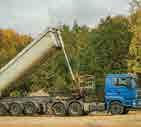
2.5 million years ago: Early humans use basic tools such as stone wedges for cutting and shaping.
3500 BCE: The wheel and axle are first used in Mesopotamia for pottery making.
3000 BCE: Ancient people use a long wooden lever called a shaduf to lift water.
2550 BCE: Egyptian Pharaoh Khufu orders the construction of the Great Pyramid to begin. Workers use the lever to move large stones for pyramid construction.
400 BCE: The first waterwheels and water mills are used to power machines in the Persian Empire.
312 BCE: Ancient Roman engineers begin the construction of a system of aqueducts that use inclined planes to carry water to cities and towns.
250 BCE: Archimedes develops the Archimedes’s screw to move water from a lower level to a higher level.
73-74 CE: The Roman army builds a massive earth ramp to attack the Jewish fortress at Masada.
100: The first wheelbarrows appear in China during the Han Dynasty.
500 to 1000: Some of the first spinning wheels appear in India.
600: Windmills are used in the Middle East.
1100s: Gears are used in medieval clocks and later in other machines such as mills.
1400s: Leonardo da Vinci sketches designs for mechanical systems using simple machines.
1450: German inventor Johannes Gutenberg uses screws to build his printing press.
1500s: The use of gears expands in clocks, pumps, and other machines in Europe.
1687: Isaac Newton formulates his three laws of motion and gravity.
1700s: The steam engine is developed and uses multiple simple machines such as levers and pulleys.
1700s: The American pioneers use wedge-shaped axes and tools to split logs to build fences and buildings.




1794: American inventor Eli Whitney patents the cotton gin, which uses a screw mechanism to separate cotton fibers and cotton seeds.
1804: British inventor Richard Trevithick builds a steampowered locomotive, combining several simple machines.
1834: English mathematician Charles Babbage invents the analytical engine, which incorporates gears and levers as key components.
1850s: Engineers design elevators that use pulleys for lifting.
1858: American inventor John Landis Mason invents the Mason jar, a glass jar with a special screw-on lid that can be used to preserve food.
1888: The invention of air-filled tires makes rides smoother for vehicles.
1870s: American inventor Thomas Edison develops various devices using levers and gears in electric motors.
1893: George Ferris builds his Ferris wheel for the World’s Fair in Chicago.
1914: The Panama Canal is completed with the help of pulleys and cranes.
1920s: Vehicles begin using steel wheels, which are stronger than wooden wheels.
1930s: American businessman Henry Phillips files a patent for the Phillips head screw.
1980s: Alloy wheels, which are lighter than steel wheels, make vehicles more fuel efficient and easier to control.
2000s: Modern machines, from cars to robots, rely on a combination of simple machines for efficient movement.
2002: Archaeologists discover the oldest known wooden wheel, the Ljubljana Marshes Wheel, in Slovenia. They estimate the ancient wheel is more than 5,000 years old.
2021: Amateur builders in China create the world’s largest Rube Goldberg machine. It has 427 steps and lights a neon sign.
2025: Scientists and engineers are working to develop shapechanging wheels, also known as morphing wheels. These advanced wheels can change their shape to adapt to different surfaces or driving conditions.
Introduction
An Amazing Feat

How do simple machines help us with engineering projects?

Since ancient times, engineers have used simple machines to build structures both large and small. The structure of our world—our homes, schools, bridges, monuments, skyscrapers, and more—is made possible by basic engineering concepts.


The Great Pyramid of Giza rises above a sandy plateau in northern Egypt. For more than 4,000 years, the Great Pyramid was the tallest structure in the world, initially reaching 481 feet tall. The Great Pyramid’s base is a massive square. Each side stretches 756 feet across. The entire base covers 13 acres—that makes the Great Pyramid’s base big enough to fit 10 football fields!
The Ancient Egyptians built magnificent pyramids as tombs for their kings, the pharaohs. The Egyptians believed that part of the pharaoh’s spirit stayed with his body after death. They placed the pharaoh’s body deep inside the pyramid, along with many items the pharaoh would need in the afterlife, such as treasures, jewels, and furniture. A series of mazes and dead-end passages inside the pyramid protected the pharaoh and his treasures. The entrance to the burial chamber was often blocked with heavy stone blocks or the burial shaft was filled so no one could get inside.
The Egyptian Pharaoh Khufu (died c. 2566 BCE) ordered the construction of the Great Pyramid to begin around 2,550 BCE. Thousands of skilled workers, including stone masons and carpenters, came from communities throughout Ancient Egypt. They lived in a temporary city near the building site while they worked on the Great Pyramid.
The Ancient Egyptians used an estimated 2.3 million limestone and granite stone blocks to build the Great Pyramid. Most of the stone came from nearby quarries on the Giza plateau. Some stone came from quarries hundreds of miles away. Each block weighed an average of 2.5 tons, about 5,000 pounds. That’s some pretty heavy building blocks!
Archaeologists believe the Egyptians used copper chisels to cut each stone to specific measurements. They placed the quarried stone on a wooden sled and pulled it to where it would be placed. Workers placed stone blocks in a square to form the pyramid’s base.
How did the workers move the heavy stones to the pyramid’s higher levels? Remember, they didn’t have cranes or giant bulldozers. Without modern construction equipment, the stones would have been impossible to lift to the pyramid’s highest points.
FULL STEAM
Two other significant pyramids were built at Giza, for Egyptian pharaohs Khafre and Menkaure.
Instead, archaeologists believe the workers built sloping ramps to move the heavy stone blocks to the pyramid’s next level. The sloping ramps were likely built from mud, wood, and stone. Workers pushed, pulled, and dragged stones up the ramps using ropes made from papyrus.
THE SCIENTIFIC METHOD
The scientific method is the process scientists use to ask questions and find answers. Keep a science notebook to record your methods and observations during all the activities in this book. You can use a scientific method worksheet to organize your ideas and observations.
Question: What are we trying to find out? What problem are we trying to solve?
Research: What is already known about this topic?
Hypothesis: What do we think the answer will be?
Equipment: What supplies are we using?
Method: What procedure are we following?
Results: What happened and why?
Primary sources come from people who were eyewitnesses to events. They might write about the event, take videos, post messages, or record the sound of an event. For example, photographs are primary sources, taken at the time of the event. Watch out for fakes, though! Paintings of events are usually not primary sources since they were often painted after the event took place. They are secondary sources. Why do you think primary sources are important?


Workers may have greased the ramps with water or wet clay to make pulling the stone blocks on wooden sledges easier. They slid each stone block into place using wooden logs.
FULL STEAM
The Great Pyramid is so big it can be seen from the International Space Station!
Workers placed the stone blocks in increasingly smaller squares, one layer on top of another. Once the stones were in place, the Egyptians used chisels to smooth the pyramid’s sides and cover them with stone slabs. As each layer was completed, the workers built dirt ramps to the next level. Archaeologists estimate it took about 20 years to complete the Great Pyramid.

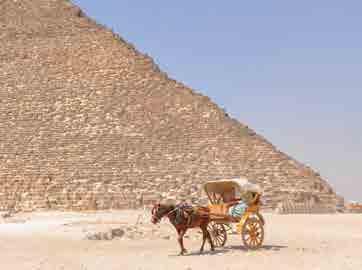
AN AMAZING FEAT
Building the Great Pyramid was an amazing engineering feat. Ancient Egypt had no flatbed trucks to haul building materials or motorized cranes to lift heavy stones. There were no forklifts, power tools, cherry pickers, computers, or other machines that the modern construction industry uses to build everything from bridges to skyscrapers.
How did the Egyptians build one of the world’s ancient architectural wonders without modern machinery?
Archaeologists believe the Egyptians accomplished this using simple machines!
Watch this feature-length PBS documentary to learn more about the Great Pyramid of Giza and how it was built. Why did egyptian rulers decide on this shape for their monuments?
PBS Decoding Great Pyramid
The Great Pyramid

For example, the large ramps built around the pyramid to move the massive stone blocks into place are a simple machine called an inclined plane. Pushing an object up an inclined plane is easier than lifting it. The Ancient Egyptians could move large stone blocks over great distances with simple machines. Building the Great Pyramid might not have been possible without the inclined plan.
WHAT ARE SIMPLE MACHINES?
Every day, humans perform work. Work can be as simple as mowing the lawn or as complex as building an airplane.
A skateboard ramp is an inclined plane, one of the simple machines. A wheel is a simple machine, too!
Throughout history, humans have invented tools to make work easier. Many human tools are based on simple machines.
A simple machine is a device that has no or few moving parts. Simple machines make work easier. They helped the Ancient Egyptians split massive rocks, lift heavy stones, and move materials long distances. With a simple machine, less force is needed to do the work. That makes the work easier!
There are simple machines all around us, from tools at home to machines worldwide. A wheelchair ramp is an example of a common simple machine called an inclined plane. You can push the wheelchair up the ramp instead of carrying it over the stairs. The ramp makes it easier to move the wheelchair to a higher elevation.
Two or more simple machines can work together to form a compound machine. For example, a wheelbarrow is a compound machine. It combines two simple machines: a lever and a wheel and axle. A shovel is another compound machine made from a lever and a wedge.
WHAT IS WORK?
To understand simple machines, we first need to understand the concept of work. Work occurs when a force acts on an object and causes a displacement of the object. In other words, a force causes the object’s position to change. There are three components of work: force, displacement, and cause. A force must act on an object, the object must be displaced, and the force must cause the displacement.
THE ENGINEERING DESIGN PROCESS
The engineering design process is a series of steps that engineers use to solve a problem.
Define the Problem: What is the problem you are trying to solve?
Research: Gather information about the problem and other attempts to solve it.
Brainstorm: Use your imagination to think up as many ideas as possible to solve the problem.
Choose a Solution: Evaluate the ideas and pick the best one.
Prototype: Build or implement the solution.
Test: Test the solution you created to see if it performs as you expected. Gather feedback and make improvements as needed.
Archimedes (c. 287–c. 212 BCE) was an Ancient Greek scientist and inventor. Archimedes lived in the Greek colony of Sicily for much of his life and traveled to Alexandria, Egypt, to study. He was fascinated by how things worked. Archimedes identified three of the six simple machines—the lever, pulley, and screw— and demonstrated how each created a mechanical advantage. He is credited with saying, “Give me a lever long enough and a place to stand, and I will move the world.”
Archimedes’s work led to several inventions, including a hydraulic screw that could raise water from a lower to a higher level. He is also credited with inventing the catapult, which the Greeks used to hurl heavy boulders at the Roman army.
Another way of saying this is that work is done when a force is used to move an object over a distance. Mathematically, work can be calculated as force times distance.
Work (W) = Force (F) × Distance (D)
Work occurs all around us. For example, think about what happens when you pick up a backpack. As you lift it, the muscles in your arm exert a force on the backpack. The backpack changes position as you raise it to your shoulder. The force exerted by your arm causes the backpack to move. Your arm is doing work.
MAKING WORK EASIER
Simple machines make work easier. They change a force’s direction, distance, or strength. For example, a pulley is a simple machine that makes work easier by changing the direction of a force. When you raise a flag on a flagpole, you pull down on a rope attached to a pulley to move the flag up.
FULL STEAM
Other simple machines change the distance of a force. Imagine you need to lift a heavy box full of books off the ground. You’ll need to exert a lot of force to pick up and move the box of books. Instead of lifting the heavy box, you could push it up an inclined plane. Pushing the box up the inclined plane is easier—but you’ll have to move it a longer distance than if you had lifted it straight up.
There are simple machines in the human body! Arms, teeth, legs—even toes are simple machines that do work to make a body function.
Some simple machines change the strength of a force. Have you ever tried to pry off a bottle cap with just your hands? No matter how hard you push and pull, the cap stays on tight. What if you tried using a bottle opener? A bottle opener is a type of simple machine called a lever. When you move the bottle opener’s handle up, you apply a force to the handle. The bottle opener strengthens the force across its length and pops off the cap.
WORK INPUT = WORK OUTPUT
Simple machines make work easier but do not change the amount of work done. In physics, energy is the ability to do work. The amount of energy that is used to do the work is equal to the amount of work that gets done. The law of conservation of energy states that energy is not created or destroyed in a closed system—it is converted from one form to another form. For example, a car engine burns gasoline, which converts the chemical energy in gasoline into the mechanical energy to do the work of moving the car.
Every job requires a certain amount of work to complete—that amount does not change. Simple machines can change a force’s direction, distance, or strength, but there will always be a tradeoff for these changes. If you use less force to move an object, you’ll need to move it over a greater distance. If you move the object over a smaller distance, you must exert a greater force on it.
Simple machines provide a mechanical advantage. They make it easier to get work done. Often, work seems hard because it requires a lot of force. Using less force, even over a longer distance, can make the work easier.
VOCAB LAB
Write down what you think each word means. What root words can you find to help you? What does the context of the word tell you?
archaeologist, compound machine, displacement, force, inclined plane, law of conservation of energy, lever, mechanical advantage, pulley, screw, simple machine, wedge, wheel and axle, and work
Compare your definitions with those of your friends or classmates. Did you all come up with the same meanings? Turn to the text and glossary if you need help.
TEXT TO WORLD
What simple machines do you see around you right now? What are they used for?
SIX SIMPLE MACHINES
There are six simple machines in engineering that we’ll be investigating in this book.



Inclined plane: An inclined plane is a flat, sloped surface. Pushing a heavy object up an inclined plane is easier than lifting it. A ramp is an example of an inclined plane.
Lever: A lever is a flat board or arm with a pivot point called a fulcrum. When you push down on one end of a lever, the other end rises. The longer the board, the easier it is to lift a heavy object on the other end. A pair of scissors and a seesaw are examples of levers.
Pulley: A pulley is a wheel on a stationary axle. You pull a rope connected to the wheel to raise an object. A pulley is what raises the flag on a flagpole.
Screw: A screw is an inclined plane called a thread wrapped around a rod. When you turn a screw, it pulls two things together. The cap on a water bottle is an example of a screw.
Wedge: A wedge is wider at one end and tapers to a point. Wedges are used to split things, hold things, or push something apart. An axe is an example of a wedge.
Wheel and axle: A circular wheel is connected to a thin rod called an axle. When the wheel turns, the axle also turns. A wheel and axle lift and move loads. Cars use wheels and axles to move.
Mechanical, structural, civil, and many other types of engineering are based on the six simple machines that humans have been using for thousands of years. The inclined plane, lever, pulley, screw, wedge, and wheel and axle are used to build roads, skyscrapers, vehicles, engines, and even other tools. They are the building blocks from which all more complicated machines are built.
In this book, you’ll discover the mechanics behind the six simple machines, along with their history, evolution, and potential future. Let’s get to work with simple machines!
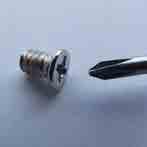
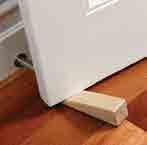
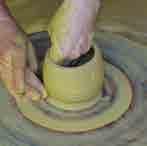
KEY QUESTIONS
• How did some ancient civilizations build towering structures without the benefit of modern machinery?
• What is the mathematical definition of work? How do simple machines change the amount of work a person needs to do?

Inquire & Investigate
To investigate more, choose one of the tools you use at home. What do you use this tool to do? How does this tool help you? How would you accomplish the same task if you did not have this tool? Why does the tool make work easier? What is the tradeoff?
WHERE ARE THE SIMPLE MACHINES?
Humans have been using simple machines for centuries. Simple machines make work easier. They create a mechanical advantage that reduces the force or effort needed to complete a job. You have probably used simple machines without even knowing it! In this activity, you’ll investigate which simple machines you use at home.
• Look around your house for small tools or gadgets that use one or more simple machines. For example, you might find scissors, a corkscrew, can opener, garlic press, barbecue tongs, hand drill, wind-up toy, pencil sharpener, stapler, garage door opener, shovel, knife, wagon, wheelbarrow, and more.
• For each tool or gadget you find, determine which simple machine it uses to work. Is the tool a compound machine? If yes, what simple machines does it combine? You might need to do a little research about the six types of simple machines: inclined plane, lever, pulley, screw, wedge, and wheel and axle.
• Create a data table with the information you collect. How many of each type of simple machine did you find? What type of simple machine was most common in your home? What was the least common? Make a graph of your data.
• Share your graph with your class. How do your results compare with those of your classmates? What was the most common simple machine for the entire class? What was the least common simple machine?
